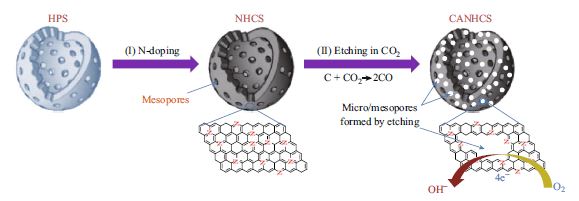Nano-Micro Letters ( IF 26.6 ) Pub Date : 2017-09-03 , DOI: 10.1007/s40820-017-0157-1 Ruohao Xing , Tingsheng Zhou , Yao Zhou , Ruguang Ma , Qian Liu , Jun Luo , Jiacheng Wang

|
A series of triple hierarchical micro-meso-macroporous N-doped carbon shells with hollow cores have been successfully prepared via etching N-doped hollow carbon spheres with CO2 at high temperatures. The surface areas, total pore volumes, and micropore percentages of the CO2-activated samples evidently increase with increasing activation temperature from 800 to 950 °C, while the N contents show a contrary trend from 7.6 to 3.8 at%. The pyridinic and graphitic nitrogen groups are dominant among various N-containing groups in the samples. The 950 °C-activated sample (CANHCS-950) has the largest surface area (2072 m2 g-1), pore volume (1.96 cm3 g-1), hierarchical micro-mesopore distributions (1.2, 2.6, and 6.2 nm), hollow macropore cores (~91 nm), and highest relative content of pyridinic and graphitic-N groups. This triple micro-meso-macropore system could synergistically enhance the activity because macropores could store up the reactant, mesopores could reduce the transport resistance of the reactants to the active sites, and micropores could be in favor of the accumulation of ions. Therefore, the CANHCS-950 with optimized structure shows the optimal and comparable oxygen reduction reaction (ORR) activity but superior methanol tolerance and long-term durability to commercial Pt/C with a 4e--dominant transfer pathway in alkaline media. These excellent properties in combination with good stability and recyclability make CANHCSs among the most promising metal-free ORR electrocatalysts reported so far in practical applications.
中文翻译:

具有中空核的三层微中微巨氮掺杂碳壳对电催化氧还原反应的产生
通过在高温下用CO 2蚀刻N掺杂空心碳球,成功制备了一系列具有空心核的三级微介孔大氮掺杂碳壳。CO 2活化样品的表面积,总孔体积和微孔百分比随着活化温度从800到950°C的升高而明显增加,而N含量则从7.6 at到3.8 at%呈现相反的趋势。吡啶和石墨氮基团在样品中的各种含N基团中占主导地位。950°C活化的样品(CANHCS-950)具有最大的表面积(2072 m 2 g -1),孔体积(1.96 cm 3 g -1)),分层的微孔分布(1.2、2.6和6.2 nm),空心大孔核(〜91 nm)以及吡啶和石墨N基团的相对含量最高。这种三重微介孔-大孔系统可以协同增强活性,因为大孔可以储存反应物,中孔可以降低反应物对活性位的转运阻力,而微孔可能有利于离子的积累。因此,具有优化结构的CANHCS-950表现出最佳和可比的氧还原反应(ORR)活性,但具有优于4e-的商用Pt / C的甲醇耐受性和长期耐久性。-在碱性介质中的主要转移途径。这些优异的性能与良好的稳定性和可回收性相结合,使CANHCS成为迄今为止在实际应用中报告的最有希望的无金属ORR电催化剂。



























 京公网安备 11010802027423号
京公网安备 11010802027423号